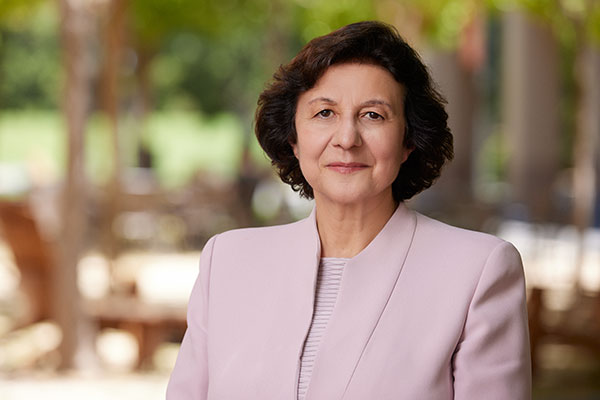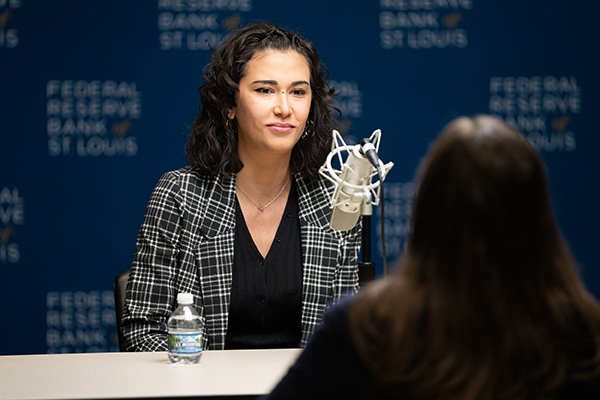Choosing to Bring Economic Education to More Students
As a young person, Justin Wolfers was interested in choices; more specifically, how the odds that affect betting decisions are measured and how bets are placed.

Justin Wolfers
Photo via University of Michigan
“I wanted to become a professional gambler and I had an apprenticeship with a bookie,” Wolfers tells the St. Louis Fed’s Teach Economics podcast. “I got fired after my first week.”
Despite the setback, Wolfers had a good foundation to fall back on. His high school economics teacher Ray Lees had sparked an interest in economics for Wolfers.
“He treated me like a grown-up,” Wolfers says. “I wanted to learn more about economics, and he told me how to go do it.”
Wolfers chose to follow Lees’ advice, and today he’s professor of public policy and economics at the University of Michigan.
He says teaching students to think like an economist is important because it empowers them to make better informed decisions about everything from whether to continue watching a bad movie to whether to rent or buy a home. Yet for many students access to these skills is limited.
“Too often economics is an afterthought,” Wolfers says.
Promoting and improving economic literacy is a critical part of the St. Louis Fed’s mission, and it led the Bank’s Economic Education team to create both the Teach Economics and Women in Economics podcast series. As the fall semester begins to wind down, let’s take a step back to explore some of the insights we’ve heard from guests about common obstacles to expanding economic education, and what we could do to overcome them.
Limited Exposure
Arguably the single largest impediment to bringing economic education to more students: Making sure they learn about it in the first place.
Only 28 states require students to take a course in economics (PDF) to graduate, according to the Council for Economic Education’s 2024 Survey of the States. That leaves many high schoolers without any formal instruction or exposure to economics.

Annamaria Lusardi
Exposure to economics often doesn’t improve in college. From 60% to 75% of college students never take economics, as Avi Cohen, Wendy Stock and Scott Wolla noted in a Dec. 11, 2023, Journal of Economic Education article. “Among students who do take introductory economics, for the vast majority, it will be the only economics course they ever take, and only 2 percent will go on to major in economics,” they wrote.

Greg Mankiw
It’s a predicament that’s not lost on Greg Mankiw, Harvard University economics professor and author of the popular textbook Principles of Economics.
“They’re probably going to forget the specific models, but they’re going to probably understand the world view, the perspective that they’re getting,” Mankiw tells the Teach Economics podcast. “And that, I think, is really what we’re trying to ultimately leave them with.”“Bueller? Bueller? Bueller? Bueller?”
For students who do take an economics class, it can be a notoriously difficult subject to grasp, let alone apply to the world around them. And for those who study economics in college, their instructors’ teaching styles may make it hard to connect the dots.
The stereotype of the economics lesson depicted in the movie “Ferris Bueller’s Day Off” was an exaggeration, but data have suggested that it may have rung true for many college students.
A 2014 survey of 340 economics instructors found many relied heavily on teaching styles that lacked direct engagement for students with the subject matter. The median respondent reported spending 70% of class time lecturing, 20% leading class discussion, and only 10% using more active learning activities. Research has shown “active” learning is more effective.
Don’t Ignore “One-and-Done” Students
When teaching an intro course, economics instructors often think about two groups of students.
The first group is made up of the students who will go on to major in economics. In the second group are the “one-and-done” students who end up taking an economics class to fulfill obligations in other majors or to gain a deeper understanding of how the economy works. For them, economic literacy is the goal.
Since instructors may be concerned about putting students who go on to major in economics at a disadvantage, many err on the side of including more models and concepts in the introductory course because they will show up in the courses that follow.
But professors could decide to take a different approach. Rather than catering to the handful of students who will move on in the field, economics professors could more actively consider the question asked for the 2023 Journal of Economic Education symposium: What should go into the only economics course most students will ever take?
Literacy-Targeted Approach
The literacy-targeted approach could serve as a model for teaching introductory economics. This approach argues that it is more valuable for students to be able to apply core economic concepts well than to be exposed to a wide range of concepts they will soon forget. And this wouldn’t just benefit the one-and-done students.
The literacy-targeted approach is what’s called Pareto-improving, or benefiting many while not making anyone worse off, according to a 2020 report published in American Economic Association Papers and Proceedings. The researchers found that it appeals to, and better serves, a broader audience than a “traditional” economics course while doing no harm to those who go on to major in economics.
Widening the Lens
It may also be helpful to look to other fields of study when considering ways to make economics more accessible. For example, in a Teach Economics episode, Bill Goffe, an economics teaching professor at Penn State, suggested that economics instructors build in teaching strategies developed by cognitive scientists to maximize learning.
“For learning, [there’s a] huge amount of useful work done in other disciplines that we can fruitfully use,” Goffe says.
Connecting economics to social issues is another way to help students understand how concepts relate to the world around them. In a March 2024 Journal of Economic Education article, economics professors Gary Hoover of Tulane University and Ebonya Washington of Columbia University argued that issues of racism and discrimination should be included in economics lessons.
Ultimately, simplifying content, teaching it clearly and making it relevant will help support a more informed and engaged public, says Harvard’s Mankiw in a February 2016 Eastern Economic Journal article.
“The typical student is not a future economist but is a future voter,” Mankiw says in the article. “I include the topics that I believe are essential to help produce well-informed citizens.”
Diversifying the Field
Daryl Fairweather enrolled at the Massachusetts Institute of Technology to study engineering but became enamored with economics during an intro class.

Daryl Fairweather
“I learned that economics was taught with math, and I really liked the way that economics studies human behavior but with this mathematical lens,” Fairweather tells the Women in Economics Podcast.
Fairweather would go on to earn a Ph.D. from the University of Chicago and is now the chief economist at real estate brokerage firm Redfin.Economists study the decisions that people make, Fairweather says. “I think that’s something that women do want to study, and I’m hopeful that more women can see economics is a place where they can fit in,” she says.
Both the St. Louis Fed’s Women in Economics and Teach Economics podcast series have revealed that some of the greatest minds in economics found economics by accident when taking a required economics course. And increasing the number of students exposed to the field can help diversify a field that in the U.S. is traditionally dominated by white men.
Choices for Making Econ More Accessible
While there are many complexities and nuances to bringing economics to more students, some basic choices could be made. For example:
- More school districts offering economics courses at the high school level
- More professors choosing to use engaging teaching styles that encourage students to think like an economist
- The field as a whole committing to create a welcoming and supportive environment for students of all backgrounds
The Economic Education Department at the St. Louis Fed is committed to providing tools and resources that can help students unlock the power of economics in their lives. And to those who teach economics, we share the gratitude of Wolfers. To Teach Economics listeners, Wolfers said: “I was one of your students and I ... want you to know what a difference you made in my life.”
This blog explains everyday economics and the Fed, while also spotlighting St. Louis Fed people and programs. Views expressed are not necessarily those of the St. Louis Fed or Federal Reserve System.
Email Us



